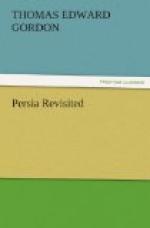In all large Persian towns there is a numerous class of ‘roughs’ known as the kullah-numdah (felt-caps; they wear a brown hard-felt low hat without a brim), excitable and reckless, and always ready for disturbance. They are the ‘casuals’, who live from hand to mouth, those to whom an appeal can be made by the careful working class when the price of bread is run up to famine figure, owing to the ‘cornering’ of wheat, which of late years has been much practised in Persia. The baker used to be the first victim of popular fury in a bread riot, and it is said that one was baked alive in his own oven. But in these times of grain speculation in Persia, the people have learnt to look in ’wheat corners’ for the real cause of dear bread, and in consequence the bread riots have become more formidable, as was proved lately at Tabriz. On a previous occasion the Vali Ahd (now H.I.M. the Shah), who, as Governor-General of Azerbaijan, resided at Tabriz, found himself unable to cope with the difficulty, and abandoned his projected visit to Tehran, so as to apply the money he had provided for it to cheapening bread for the people. This practical pocket-sympathy with them secured a popularity which will bring its reward.
Next to the ‘wheat-ring’ as a cause of disturbance and riot comes what may be called the ‘copper-ring’ of Tehran, which is likely to produce serious trouble throughout the country. The Royal Mint in Persia is worked on the farming system, the evils of which have now extended to the currency. The low price of copper allows of it being coined at an enormous profit, and advantage has been taken of this to a dangerous extent. The whole country is now poisoned with ‘black money,’ as the coppers are called, and it is at a heavy discount. This bears cruelly on the labouring classes and all who are paid in copper coin. Owing to exchange with Europe keeping above silver,




